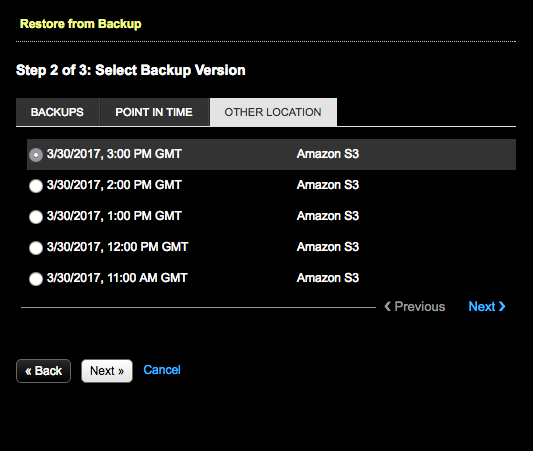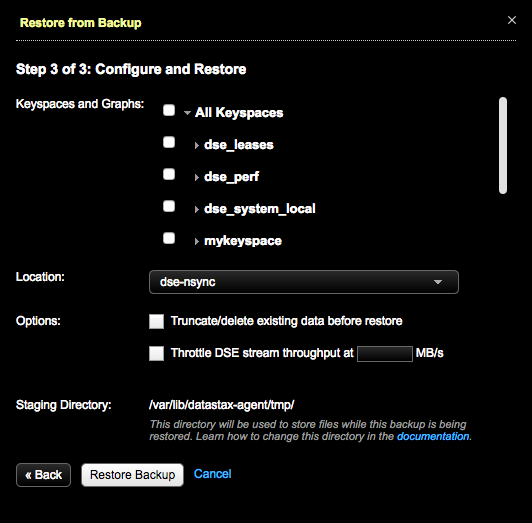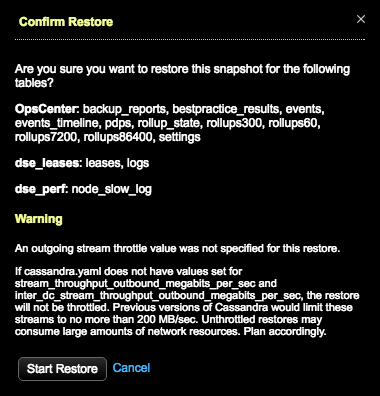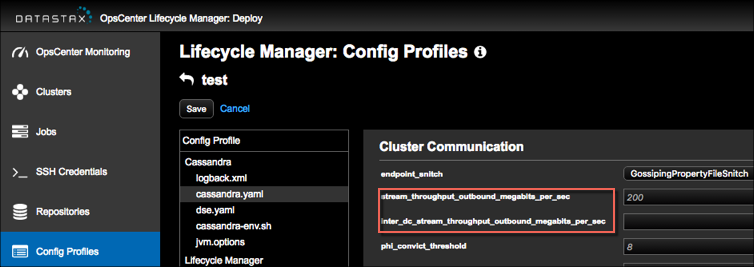Clone cluster data from a defined other location
Clone cluster data from one DSE cluster to another using the Restore Backup feature in OpsCenter. This workflow does not require the source and target clusters to both be managed by the same OpsCenter instance, and does not necessarily require another existing cluster instance. The data can be cloned, provided that it was backed up to a supported, available location.
This procedure steps you through the basic required selections in each of the three restore dialogs presented during the workflow.
When cloning a cluster:
-
Ensure the source and target datacenter names and topology are identical. See Manage datacenter topologies and Clone cluster data.
-
Ensure the encryption keys are identical when cloning encrypted tables to a different cluster.
Prerequisites
To clone the cluster data, an existing backup of the cluster to a supported location must be available. See Add a backup location.
|
Keep the following caveats in mind when creating and restoring backups:
|
|
The Backup Service requires control over the data and structure of its destination locations. The backup destinations must be dedicated for use only by OpsCenter. Any additional directories or files in those destinations can prevent the Backup Service from properly conducting a Backup or Restore operation. |
Procedure
-
Select cluster name > Services.
-
Select the Details link for the Backup Service.
-
In the Activity tab, click Restore Backup.
-
Click the Other Location tab.
The Step 1 of 3: Select Backup Restore from Backup dialog appears.
-
Select the Location from which to restore.
Available options are:
Amazon S3 or S3 Compatible -
Enter the location of the S3 bucket so that OpsCenter can locate it.
Option Description Amazon S3
Enter the Region where the S3 bucket is located.
If blank, OpsCenter will try to query S3 for the bucket region or use the
remote_backup_regionas a default.Some regions, such as China (Beijing), require a region to be specified and cannot be queried.
S3 Compatible
Enter a URL that points to an S3 Endpoint.
For example,
mys3endpoint:9000. -
Enter the S3 Bucket name.
The bucket name must be at least 4 characters long. Bucket names must only contain lowercase letters, numbers, and hyphens. Additionally, OpsCenter requires that bucket prefixes contain only lowercase letters, numbers, and safe characters. See the S3 guidelines for more details about bucket naming restrictions.
To indicate a bucket subfolder location, delineate the bucket name from the folder name with a forward slash (/) character. Example: mybucket/myfolder/mysubfolder. Remember that slashes are not allowed within bucket or folder names themselves.
-
Select the source type of your AWS credentials.
The AWS credentials and bucket names are stored in
cluster_name.conf(with the exception of ad hoc backups). Be sure to use proper security precautions to ensure that this file is not readable by unauthorized users.Option Description User-Supplied Credentials
Enter your AWS Key and AWS Secret.
AWS Credential Provider chain
Use the default credential provider chain to locate AWS credentials. See Working with AWS Credentials on the AWS website.
Microsoft Azure -
Enter the Storage Account name to which OpsCenter backs up.
-
Enter the Container Name, which is the name of the Azure Blob where OpsCenter saves backup data.
-
Enter a Storage Key for the storage container, which is an access key for the storage account that houses the Blob storage container.
Local FS -
Click Next.
The Step 2 of 3: Select Backup Version dialog appears populated with the available backups at the selected location. For more, see Add an Amazon S3 backup location.

-
Select the backup to restore and click Next.
The Step 3 of 3: Configure and Restore dialog appears.

-
In Keyspaces and Graphs, select the tables or graphs you want to restore.
-
Click All Keyspaces or All Graphs to restore all keyspaces or all graphs.
-
Click the keyspace name or graph name to include all tables or all graphs in the keyspace.
-
To select specific tables or graphs, expand the keyspace name or graph name and select the specific tables or graphs to back up.
For DSE 6.0.0-6.0.4, when restoring a DSE Graph backup without selecting Use sstableloader, DSE must be restarted to ensure all data is available.
-
-
In the Location list, select the cluster to which to clone the data.
-
When cloning data, it is not necessary to select the Truncate/delete existing data before restore option because it is a not operational for a cloning workflow. The truncate option purges data on a target before a restore runs. When using the restore feature to clone, the truncate option does not do anything because there is no data to purge before the restore runs.
-
To prevent overloading the network, set a maximum transfer rate for the restore using the Throttle DSE stream throughput at __ MB option.
To enter a value for this option, you must select Use sstableloader. Otherwise, the transfer rate value is ignored.
-
Optional: If necessary, change the staging directory by setting the
backup_staging_directoryconfiguration option in theaddress.yamlfile. -
Click Restore Backup.
The Confirm Restore dialog appears.

If a value was not set for throttling stream output, a warning message indicates the consequences of unthrottled restores. Take one of the following actions:
-
Click Cancel and set the throttle value in the Restore from Backup dialog.
-
Set the
stream_throughput_outbound_megabits_per_secandinter_dc_stream_throughput_outbound_megabits_per_secvalues incassandra.yaml. -
Proceed anyway at the risk of creating network bottlenecks.
If using LCM to manage DSE cluster configuration, update Cluster Communication settings in
cassandra.yamlin the configuration profile for the cluster and run a configuration job. Stream throughput (not inter-dc) is set to 200 in LCM defaults.
-
-
Review the information to determine if adjustments or corrections to the current schema are required :
-
To correct schema issues, click Cancel, rectify the issues, and try the restore again.
-
To proceed despite the schema mismatch, click Continue Restore.
Attempting to restore a backup with an incompatible schema might result in corrupt or inaccessible data. Before forcing the restore, back up your current data.
-
The progress and details of the restore operation are shown in the Restore Report.
